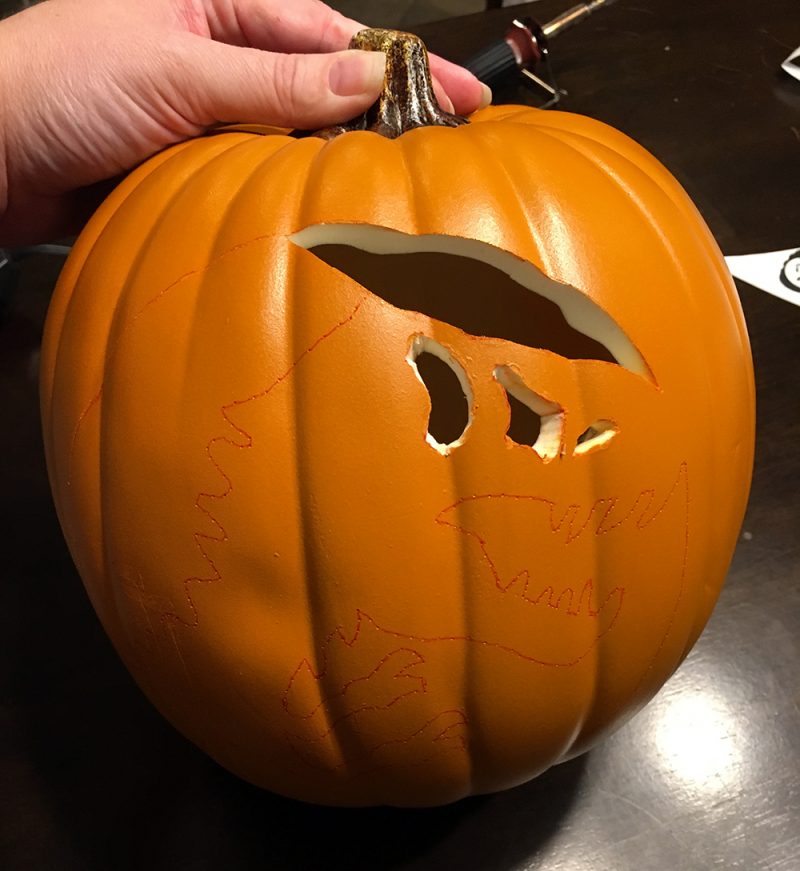Halloween is coming, my fellow fall fans! Here’s a tutorial to get you in the mood.

I’ve loved holiday-specific crafts my entire life: gingerbread house building, Easter egg dying, and most especially, pumpkin carving. I moved to Louisiana seven years ago. The first few years I was down here I’d carve a real pumpkin, and due to humidity it would be moldy in three days or less no matter what I did to try to preserve it. That’s when I discovered foam pumpkin carving!
There are several different ways and tools you can use to carve a foam pumpkin. I consider using a hot knife to be the easiest way to start, because it is the cheapest in terms of supplies you’d need to acquire. In my experience, these pumpkins will last outside for a few Halloweens before getting gross or indefinitely inside.

What you need:
- A foam pumpkin. I get mine from Michael’s, usually for about $10 with a coupon. Most craft stores will carry them starting mid-Summer.
- A hot knife. I got mine at Michael’s as well (use a coupon!). Most craft stores should carry them.
- A pattern printed on plain printer paper. If you are talented, maybe you can create your own! I am not talented in that way. There are plenty of patterns that you can find online, some free and some paid. This year I’ve started using the site Stoneykins.com. They have quite a few free patterns, and their paid patterns are pretty darn cheap. That is where the pattern you will see in this post is from. Make sure your pattern is sized appropriately for your pumpkin. The pumpkins I get are labeled 9 inches tall, and I size my pattern to be no more than 7 inches.
- Straight pins
- Scissors
- Tape
- Ink pin
- ELECTRIC candle for lighting the pumpkin when done. (Do not use a flame candle!)

Step 1: Attach your pattern
Trim you pattern and tape it you your pumpkin. Try to avoid wrinkles as much as possible within the area that will actually be carved, but some will be unavoidable.

Step 2: Trace the pattern
Trace your pattern onto the pumpkin by poking through the paper and into the pumpkin with a straight pin. There is probably an easier way of doing this, but this is the way I’ve always done it. It’s a bit tedious, but it works. I will usually go back and trace over the pattern with a ballpoint ink pin afterwards, especially if it’s a complicated design. Be careful because the ink will smear, but it’s also easy to wash off afterwards if any is left.

Step 3: Cut the candle hole
Let your hot knife heat up for a few minutes. Mine has a variable heat dial, which I usually turn to about ¾ as hot as it will go. Once your knife is hot, cut the hole so you can place the (ELECTRIC) candle when you are done. You can cut the top off like a traditional jack-o-lantern, or cut a hole in the bottom to stick a candle in. If you pattern has large openings and is not very delicate, you can skip the hole if you want and just put the candles in through the carving. That is what I’ve done with this pattern, but here are some examples of pumpkins I’ve done with top and bottom holes cut…


Step 4: Carve it!
Start with the smallest pieces toward in the middle of the design first, and work your way outward and then onto the larger parts. You may find it useful to divide your large sections into smaller sections to make them easier to work with. You may also have to adjust the heat on your hot knife. Too hot and it burns the pumpkin, too cold and it doesn’t carve effectively.

Step 5: Light it up
Admire your handiwork, light your pumpkin, and enjoy for ages!




There’s a lot of discussion in the UK right now about the environmental impact of plastics, especially single use and micro-plastics. I’m not a anti-plastic evangelist but I would have thought that foam pumpkins wouldn’t be great for the environment and would end up in landfill quite rapidly as they get damaged easily. Obviously they are more durable than their natural counterparts in humid places, but they also take much longer to break down (if at all) when they’re finished with.
I’ve had the same plastic Christmas tree since University (18 years or so?) and apparently it’s only just approaching a carbon footprint that is better than using real trees every year. Does anyone know what the difference in environmental impact is between foam and real pumpkins?
It’d also be good to see if anyone had tips for extending the life of their real pumpkins – it sounds like the writer has tried lots of things that don’t work for them now, but may in less humid environments.
If people are set on moving away from their real pumpkins, are there are biodegradable foam ones available to buy? Also has anyone any suggestions on how best to clean and store the foam ones so they can be reused for as long as possible before ending up in the bin/trash.
This was my concern, too. I doubt the foam would be able to be recycled, which was about the only thing that might mitigate it. That said, they do look easier to carve without all the faff of scooping out the insides! And the “wall” of them will be an even thickness, unlike the lopsided attempts I often end up with 🙂
I’ve heard of several ways to stop real pumpkins going mouldy, including putting bleach on them (not so environmentally-friendly!). I usually just embrace the mould as more in keeping with Hallowe’en, but I have found that if the pumpkins are outside and it’s very cold it takes longer for them to go mouldy than when they’re inside, so maybe putting them in the fridge overnight if there’s room would help. They could be put in a plastic bag if you don’t want to risk bits of mouldy pumpkin falling off in the fridge!
I’ve also wondered, if humidity is a factor, whether putting the pumpkins in the oven on a low heat to dry them out without cooking them would help. I suspect it would shrink them as they lose water so would only work with certain designs (probably nothing too detailed or intricate), though you might be able to do it after scooping them out but before carving them.
That’s a good point! I will say that most of these aren’t going to the landfill for a very long time. I usually carve them and give them away to friends and I think most of them become inside display pieces instead of outdoor pumpkins, in which case they never need to be thrown away (unless they because unwanted). I keep many of my personal collection outside during October and I’ve lost a few over the years mostly due to wind that blew them into muddy patches. Obviously nothing foam is going to last forever and they will get thrown away eventually, but I just didn’t want you to think that I’m carving foam pumpkin and then throwing them away at the end of every October like you would a real one!
This type of pumpkin is relatively permanent. No one buys them to carve and throw away. I’ve been growing my collection for 8+ years, and have yet to throw one away.
This is so adorable! I love this tutorial!